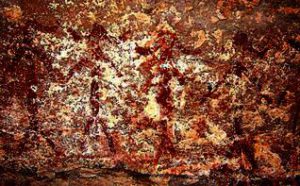Painting art in Rajasthan dates back to pre-historic era. Numerous ancient evidences certainly confirm its glorious existence.
Gadra Cave Paintings:In 2010, Bundi-based archaeologist Om Prakash Sharma alias Kukki discovered 32 sites in the rock painting stretching over the basin of Mangli river. The rock paintings are about 10,000-year-old and belong to Mesolithic-Chalcolithic period. |
|
When the Rajasthani painting art was going through its formative phase, Ajanta tradition was infusing a new life into the painting art of India. In order to avoid the ravages of the Arab invasions, many artists had left Gujarat and settled in other parts of the country. The painters who came to Rajasthan area, co-ordinated the style of Ajanta tradition with the local traditions. Till 12th century, Jain Granths and Jain Style (Also called as Gujarati or Apbransh Style) dominated the styles of Rajasthani Painting. In the 13th century, a Mewar Jain painting style developed in the form of small illustrations of the Jain Tirthankaras and some themes from the Kalpasutras.
After 15th century, Rajasthani Painting style developed independently from Apbhransh style.
Audh Niryukti Vritti & Das Vaikalika Sutra Churni are the oldest (1060 A.D.) surviving paintings of Rajasthan being kept preserved at Jaisalmer library.
Rajput Paintings
Under the Royal patronage various styles of paintings developed, cultivated and practiced in Rajasthan and reached its pinnacle of glory by 15th to 17th centuries. The major painting styles are:
- Phad Paintings,
- Miniature Paintings,
- Kajali Paintings,
- Gemstone Paintings
Rajasthani Painting Themes
- Events of epics like the Ramayana and the Mahabharata, Krishna’s life, beautiful landscapes, and humans.
- Precious stones, Gold and silver were used
- Mughal Influence
- Dominance of Chaurapanchasika group style in Indian Rajasthani Paintings
Schools of Rajputana Paintings:
Starting from the 16th century, when the Rajput Painting originated, numerous schools emerged, including:
| Mewar School | Chavand, Nathdwara, Devgarh, Udaipur and Sawar |
| Marwar school | the Kishangarh, Bikaner, Jodhpur, Nagaur, Pali and Ghanerao styles |
| Hadoti school | Kota, Bundi and Jhalawar styles |
| Dhundar school | Amber, Jaipur, Shekhawati and Uniara styles |
| Pahari school | Himachal (kangra & Kullu) & Jammu and Kashmir |
Rajasthani Painting: MEWAR
- Drawing is bold and the colours are bright and contrasting.
- Text of the painting is written in black on the top against the yellow ground.
Rajasthani Painting: BUNDI
 Very close to the Mewar style
Very close to the Mewar style- Rich and glowing colours, the rising sun in golden colour, crimson-red horizon, overlapping and semi-naturalistic trees
- Mughal influence is visible in the refined drawing of the faces.
Rajasthani Painting: KOTAH
- Very much akin to the Bundi style
- Themes of tiger and bear hunt were very popular at Kotah.
- Most of the space is occupied by the hilly jungle which has been rendered with a unique charm.
Rajasthani Painting: AMBER – JAIPUR
- This school of painting originated at Amber but later shifted to Jaipur, the new capital.
- There is a fairly large number of portraits of the Jaipur rulers
Rajasthani Painting: MARWAR
 Executed in a primitive and vigorous folk style
Executed in a primitive and vigorous folk style- completely uninfluenced by the Mughal style.
- A large number of miniatures comprising portraits, court scenes, series of the Ragamala and the Baramasa, etc. were executed from the 17th to 19th centuries at several centres of painting like Pali, Jodhpur and Nagour etc. in Marwar.
Rajasthani Painting: BIKANER
- Bikaner had close relations with the Mughals.
- Some of the Mughal artists were given patronage by the Bikaner court
- responsible for the introduction of a new style of painting having much similarity with the Mughal and the Deccani styles.
Rajasthani Painting: KISHENGARH
- developed under the patronage of Raja Savant Singh (1748-1757 A.D.), who wrote devotional poetry in praise of Krishna
- master painter Nihal Chand who, in his works, has been able to create visual images of his master’s lyrical compositions

